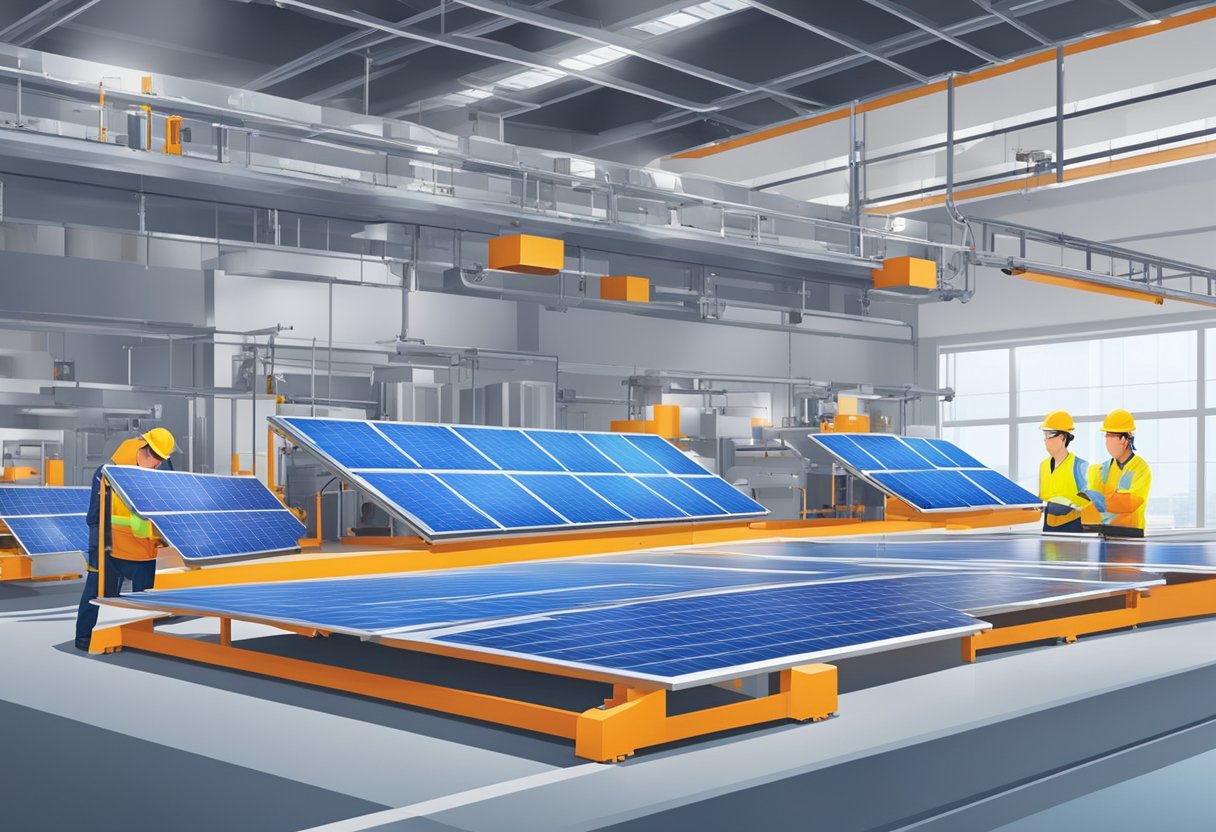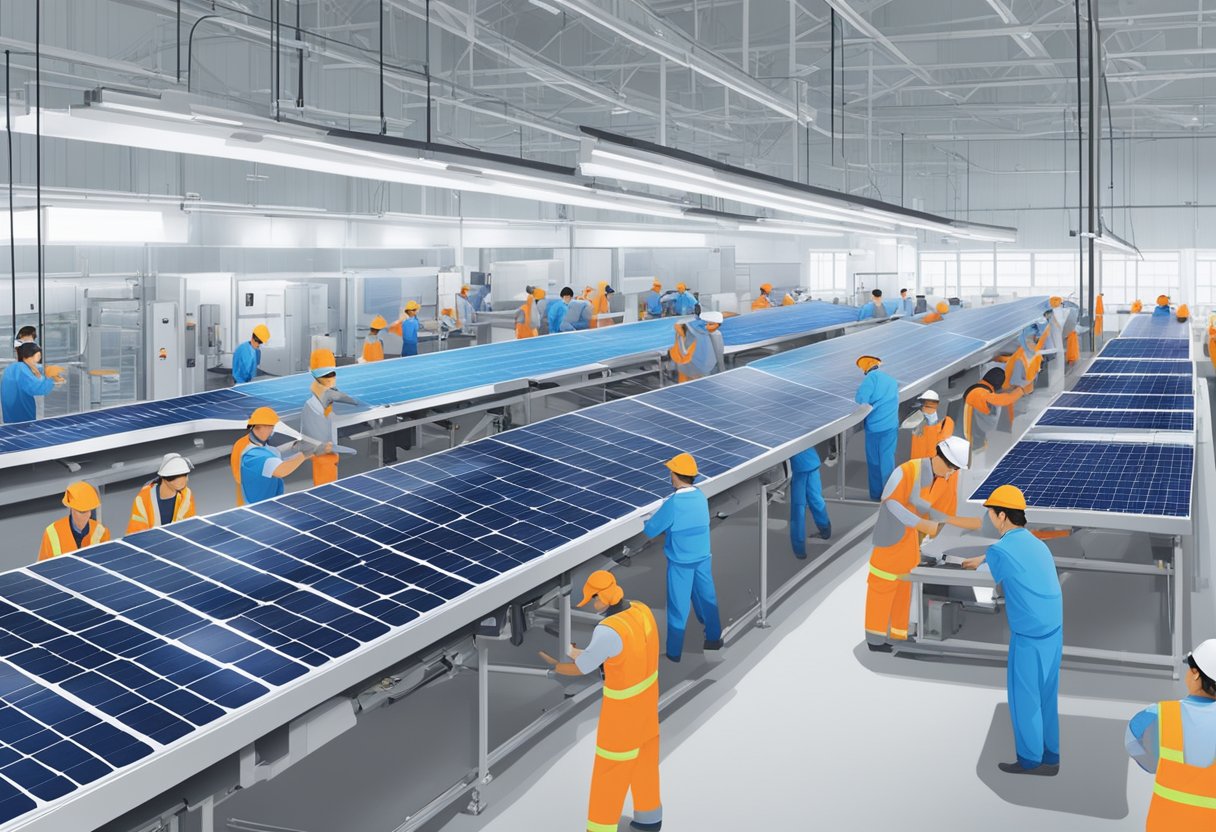China has established itself as a global leader in the production of solar panels. The country’s manufacturers have harnessed extensive industrial capabilities and technological advancements to mass-produce photovoltaic modules efficiently. This scale of production has not only met domestic demand but has also made China a pivotal supplier in the international solar market. The manufacturers prioritize both research and development and large-scale deployment, which has led to a significant reduction in the cost of solar panels worldwide.

Among the most prominent solar panel manufacturers in China are companies like JinkoSolar, JA Solar, and Trina Solar. These manufacturers dominate the market by offering a range of solar products that are known for their efficiency and reliability. Their production lines are often equipped with the latest solar technologies such as monocrystalline silicon, bifacial modules, and advanced cell structures like half-cell and tiling ribbon designs. The sheer volume of production and the utilization of cutting-edge technology have positioned these manufacturers at the forefront of the solar industry.
Chinese manufacturers’ ability to provide solar panels at competitive prices has catalyzed the global adoption of solar energy. The country’s commitment to renewable energy and the government’s support of solar technology innovation have further entrenched the status of Chinese solar panel manufacturers as key players in the green energy revolution. With ongoing advancements and a focus on sustainable practices, they continue to play a critical role in shaping the future of solar energy.
Overview of China’s Solar Industry

In the past decade, China has emerged as a dominant player in the global solar industry, with substantial investments and a comprehensive approach that aligns industry growth with sustainability goals. This section sheds light on China’s journey in the solar sector, current market conditions, and the support mechanisms fostering its unprecedented expansion.
History and Growth
China’s solar photovoltaic (PV) market has seen exponential growth, evolving rapidly from a modest participant to a global leader. It was a strategic decision to invest heavily in the solar industry, transforming the nation into the main hub for photovoltaic manufacturing. This advancement is well-reflected by the substantial investment of $130 billion in 2023, emphasizing the country’s commitment to leading the solar sector.
Market Dynamics
The dynamics of China’s solar market are influenced by both domestic demand and its dominance over the global supply chain. With over 80% control of the solar supply chain, from polysilicon to solar modules, China holds a pivotal position in determining worldwide pricing and technology trends. This dominance is further established by home-grown companies investing billions, such as a solar module maker’s recent $5.9 billion investment in new production facilities.
Policy Support and Environmental Impact
China’s government has been pivotal in the solar industry’s expansion through favorable policies and incentives. Significantly, the policy frameworks in place have not only accelerated the industry’s technological advancements but also played a crucial role in reducing the solar energy cost. This support is rooted in China’s broader agenda to transition towards sustainable and renewable energy sources, reducing reliance on fossil fuels and minimizing the environmental impact.
By aligning its economic and environmental goals, China has successfully positioned itself as a central force in the global shift towards solar power. The nation’s approach serves as a model for robust policy support driving sustainable industry growth.
Leading Chinese Solar Panel Manufacturers
China’s solar panel industry is renowned for its scale and innovation, with several companies emerging as global leaders in photovoltaic (PV) module supply. The following sections spotlight three premier solar panel manufacturers that have significantly contributed to China’s dominant position in the global market.
Longi Solar
Longi Solar has established itself as a heavyweight in the solar industry, consistently pushing the boundaries of PV module efficiency. In 2021, it was recognized as the world’s largest solar panel provider, underscoring its pivotal role in solar technology advancement. Their focus on monocrystalline silicon products has set new standards for the industry in both performance and cost-effectiveness.
Jinko Solar
Another notable entity is Jinko Solar, one of the most prolific solar panel manufacturers not just in China, but globally. Their reputation is built upon high-quality manufacturing processes and a strong commitment to sustainable and environmentally responsible practices. Jinko Solar’s diverse portfolio ensures their presence across various market segments, from utility-scale installations to residential rooftop solutions.
Trina Solar
Completing this triad of solar manufacturing excellence is Trina Solar, a veteran in the space with a strong global footprint. Trina Solar has been a consistent top performer, known for its reliable and innovative PV modules that cater to a wide range of applications. With a keen interest in research and development, Trina Solar continues to pioneer new technologies that enhance efficiency and drive down costs.
These manufacturers are part of an industry where companies like JA Solar, Yingli Solar, and Suntech have also made significant strides, further solidifying China’s status as a powerhouse in solar technology. They all contribute to a competitive and fast-evolving landscape where Chinese solar panel manufacturers are known for their ability to quickly scale-up production and drive innovation in solar panel technologies.
Manufacturing Processes and Technologies
China’s solar panel manufacturing industry is characterized by sophisticated processes and continual technological advancements. The production of silicon wafers, solar cell innovation, and module assembly techniques are integral to the industry’s ability to enhance efficiency and performance, meeting the growing global demand for renewable energy solutions.
Silicon Wafer Production
The foundation of solar panel production starts with polysilicon—the primary material used to create silicon wafers. Manufacturers in China have optimized the silicon wafer production process, relying on cutting-edge technology to cast ingots and slice them into thin wafers. Efficiency in this phase is critical, as it sets the stage for the overall performance of the final solar panels.
Solar Cell Innovation
At the heart of solar panel efficiency are the solar cells themselves. In China, solar manufacturers focus on innovation in cell technology to boost the conversion of sunlight to electricity. Through advanced research and development, they implement novel cell designs and surface treatments that enhance light absorption and reduce electron recombination, thereby improving the performance of the cells.
Module Assembly Techniques
Once the wafers are processed into cells, the next step is module assembly. Chinese manufacturers employ state-of-the-art techniques to arrange and interconnect cells within a solar panel, ensuring optimal energy output. The encapsulation of these cells aims to protect them from environmental factors while maximizing their lifespan and efficiency. Through meticulous assembly techniques, the durability and reliability of solar panels are significantly enhanced.
The technology and innovation within China’s solar panel supply chain are continuously evolving. As a result of these advancements, the nation maintains its position as a dominant force in global solar panel production, wielding considerable influence over the industry’s future trajectory.
Quality and Performance Standards
Solar panel manufacturers in China are subject to distinct performance and quality standards, with efficiency and durability being core focus areas. These standards are integral for both consumer trust and the advancement of solar technology.
Efficiency Measurement
The efficiency of solar panels is determined by their ability to convert sunlight into electricity. Chinese solar panel producers typically utilize monocrystalline and polycrystalline solar modules. Monocrystalline panels are known for high-efficiency rates due to the purity of the silicon used, often reaching peak efficiency levels above 20%. In contrast, polycrystalline panels, while cost-effective, usually have a lower efficiency benchmark. Measurement of efficiency is crucial as it directly impacts the performance and economic viability of the solar systems installed.
Durability and Warranty Issues
Durability is assessed through rigorous testing to ensure panels withstand environmental stress over time. Manufacturers often provide warranties to certify that their panels will maintain a certain level of performance—usually above 80% of the nominal power—after 25 years. Quality concerns are addressed through these warranties, reassuring clients about long-term reliability and performance issues. The Chinese solar panel market has seen a push towards better quality control to maintain competitive standards in the global arena.
Global Impact and Competitive Landscape
China’s solar panel manufacturers are poised to significantly influence the global market through competitive pricing and extensive investment in solar technology. The nation’s growth in this sector not only bolsters its own demand but also the export potential worldwide.
Export Markets
China’s solar companies have robust export markets, particularly in countries like India and those across Europe. In 2024, the influence of these solar exports is expected to remain strong, fortifying China’s position as a key global supplier. India is one of the largest importers of Chinese solar panels, relying on their low costs and technological advancements.
- Major Export Destinations:
- India: High dependency on Chinese panels.
- Europe: Increasing imports despite efforts to boost local manufacturing.
- United States: Significant market size with complicated trade dynamics.
Competitiveness with International Brands
Competing against international brands, Chinese solar panel manufacturers offer products at significantly lower costs. This pricing advantage stems from economies of scale and government subsidies, posing a challenge for solar companies in the United States, Japan, and the UK, who often contend with higher production costs.
- Factors in Competitive Edge:
- Cost Efficiency: Unmatched production scale leading to lower cost.
- Technological Innovation: Continuous investment in R&D.
- Policy Support: Strong government backing driving industry growth.
Investment and Growth Prospects
China’s solar panel manufacturing industry is bolstered by heavy domestic and foreign investments. In 2023, the investment in the solar sector has been substantial, projecting the nation to hold over 80% of the global manufacturing capacity through 2026. These strategic investments anticipate not only meeting China’s internal demand for renewable energy but also securing its dominance in the global solar market.
- Investment Highlights:
- Internal: Over US$130 billion invested in the industry in 2023.
- External: Attraction of foreign capital due to favorable market conditions.
China’s rise as a solar powerhouse impacts the global solar manufacturing landscape and demonstrates a trajectory of continued growth and influence in the coming years.
